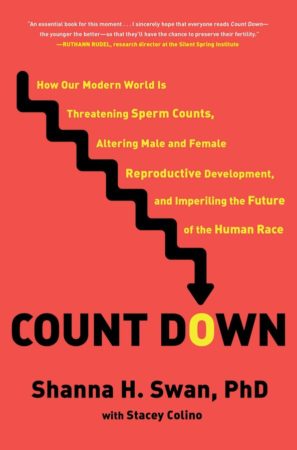 Countdown: How Our Modern World is
Countdown: How Our Modern World is
Threatening Sperm Counts, Altering Male and
Female Reproductive Development, and Imperiling
the Future of the Human Race
Shanna H. Swan by Scribner, $37, 292 pages)
Fertility rates have been declining precipitously globally but especially in the west over the past few decades. In Countdown, Shanna Swan, an environmental and reproductive epidemiologist, explores the health and cultural implications of her 2017 meta-analysis that found between 1973 and 2011 mean sperm concentration declined 52.4 per cent in Australia, Europe, New Zealand, and North America. There are a number of reasons for this decline but Swan focuses mostly on chemicals in the environment and unhealthy lifestyles, which both disrupt hormonal balance. Perhaps the most famous examples of this are elevated levels of estrogen in lakes resulting in effecting the reproductive organs of wildlife. Not only do these physiological changes reduce fertility but they change behavior in people, too; sometimes this influence can be passed epigenetically (that is, the environment in utero). For example, pregnant women who take Tylenol might increase the chances of their offspring having gender dysphoria (transgender identification). Swan (too briefly) explores the possibility that “endocrine disrupting chemicals” (EDCs) may “interfere with complex biochemical pathways in the brain in ways that may affect how a person associates with his or her physiological sex at birth or express their gender through behavior, either of which may result in gender dysphoria.” She acknowledges that “getting to the root of whether EDCs are influencing gender identity is difficult.” Still, the role of environment should give pause to the mania to affirm every gender-confused teen and re-orient the policy discussion for a brief timeout as policymakers consider the regulation of chemicals that might radically alter how we perceive ourselves in unhealthy ways.
Of course, the primary implication of lower sperm counts is reduced fertility rates, and Swan notes that there is little that can be done to cure male infertility. Swan points out that many couples look toward assisted reproductive technologies, but she warns they are no panacea. She notes that lifestyle choices, including putting off having a first child until later in life, affects the number of children women have, but waiting also reduces the chances of getting pregnant. Fertility rates have fallen by half over the last 60 years but interestingly the ability to conceive a pregnancy and carry to term has fallen more dramatically among younger women than older ones.
Swan concludes with an ambitious agenda for regulating EDCs, including the development and quick approval of “green chemistry” alternatives and lower-dosage EDCs in the meantime. The necessary first step to smarter regulation, however, is information, and despite the fact that Swan’s 2017 study received widespread attention, there has been little interest by governments to address the myriad ways in which sperm counts, menstrual cycles, and ovulatory patterns are being thrown out of whack by the chemicals we put into our bodies and those we absorb from the broader environment.




